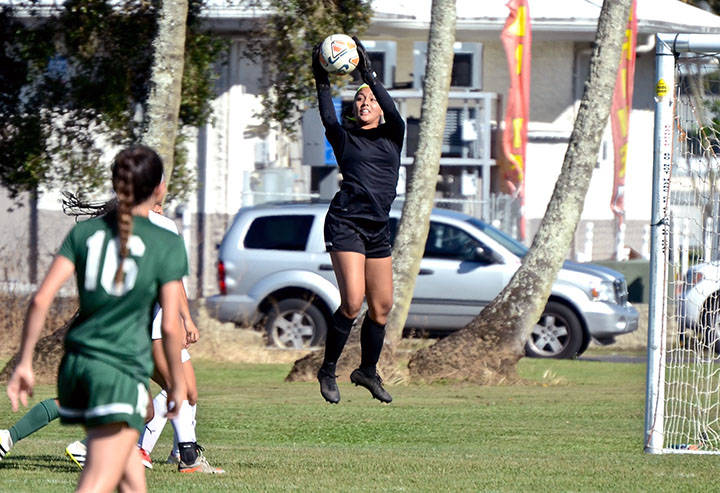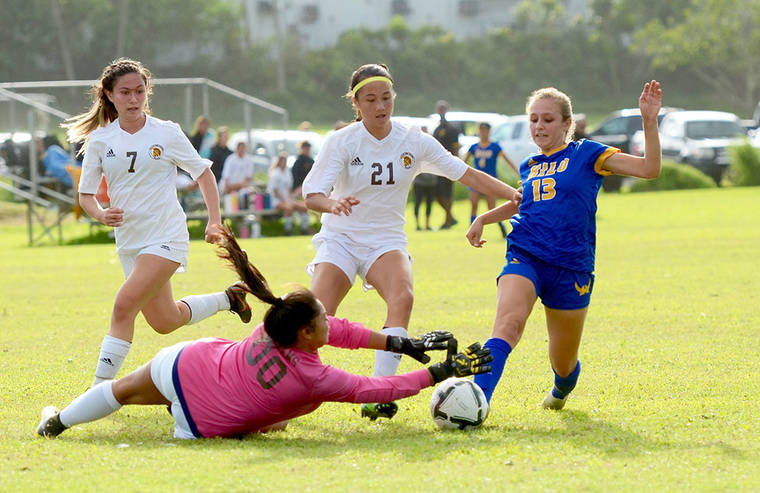Welcome home, ladies: UHH soccer looks for boost from infusion of local talent

JARED FUJISAKI photo Saydee Bacdad spent four seasons protecting the goal for Hilo High, and she’ll try to do the same for the Vulcans.

JARED FUJISAKI photo After one season at Northern Arizona, former prolific Hilo High goal scorer Jordyn Pacheco, right, will start her career with the UH-Hilo women’s soccer team Monday when the Vulcans hold their first official practice.
The last time a talented local girl returned home to play for the UH-Hilo women’s soccer team, Megan Pachecano brought a friend, Adele Letro, and together they changed the program for one brilliant season.
The last time a talented local girl returned home to play for the UH-Hilo women’s soccer team, Megan Pachecano brought a friend, Adele Letro, and together they changed the program for one brilliant season.
In 2008, Pachecano, who’s from Pahoa and played at a California junior college, and Letro, a Division I transfer from Division I Utah, set a single-season school record with 14 goals each to help Travis Clarke, the program’s first coach, use UHH’s success as a springboard to eventually land a job at Division I Saint Mary’s College.
ADVERTISING
The Vulcans went 13-7 and placed third in the PacWest, and after Clarke left in 2008, the team has longed to find scorers as talented as Pachecano, who was an accurate shooter, and Letro, who was a dribbling dynamo.
Even when UHH coach Gene Okamura went 10-4-2 with a PacWest runner-up finish in 2018, the Vulcans didn’t have a double-digit scorer. Jaime Salas, a Division I transfer from Arizona State, led the team with just five goals.
Okamura, who’s in his sixth season, is hoping history repeats itself with his recruiting class of a dozen players, including four Division I transfers, particularly 2019 Hilo High graduate Jordyn Pacheco, who played at Division I Northern Arizona and is regarded as one of the all-time greats in BIIF history.
Pacheco will be joined by a few BIIF pals, including 2019 Hilo graduate and goalie Saydee Bacdad, who played at Division I Utah Valley State; 2018 Konawaena graduate Nalani Wall, who played at Division II Fresno Pacific; and 2021 Waiakea graduate Jacelyn Cambra, who played for Okamura’s club team, Hawaii Rush. Wall joins her sister, sophomore forward Nanea Wall, a 2019 Konawaena graduate.
The other recruits are Filippa Graneld, who’s from Sweden and played at Division I Colorado and for the U18 and U19 Swedish national teams; Alyssa Padron, who’s from Palos Verdes, Calif., and played at Division I UC Davis and was the league MVP in high school; Anna Carrier, who’s from Colorado and played at Division II Saginaw Valley State; Juliet Hufford, who’s from Seattle and played for Ottawa University of the NAIA and was defender of the year in high school; Silige Vigeland, who’s from San Diego and played for Mira Costa College, where she scored 11 goals in 12 games for the junior college team; Jordan Parrish, who’s from Torrance, Calif., and was an all-league pick for Bishop Montgomery High; Michelle Alvarez, who’s from Highland, Calif., and Tichalynn Barroga, who’s from Moanalua High and played for Hawaii Surf Soccer Club.
Last season, the Vulcans finished 0-0-4 during the COVID-19 year and scored five goals against Chaminade and Hawaii Pacific during a Hawaii pod schedule. In 2019, UHH went 6-7-4 with another four ties where a goal here or there could have led to a much better record.
So why is it so difficult to put a ball in the back of the net or find a good goal scorer?
“Good question,” Okamura said. “With all due respect to the previous years, the level of competition has risen. Our conference is tough, so that’s a big factor.”
That’s true and what’s also true is that good goal scorers don’t grow on trees. For comparison’s sake, not every Major League Baseball team has a player as talented as Mike Trout. It’s the same deal with college soccer.
Kristine Pasek leads UHH in career goals with 25 from 2011 to ’14. Her season-high was just eight goals in 2012.
That’s where the Pacheco and Trout story comes in.
Pacheco was the BIIF player of the year in 2019 and led the league in scoring her junior and senior seasons. Yet when she went to Northern Arizona, she played defensive halfback and was told she’s too short to score on headers.
Diego Maradona, the “Hand of God” soccer legend from Argentina, stood 5 feet 5, only two inches taller than Pacheco.
But when the Lumberjacks recruited her, a different coach took over when she arrived on the Flagstaff, Ariz., campus. So that sort of makes a bit of sense.
When her school shut down due to the pandemic, Pacheco, who’s majoring in nursing, was home for a year and decided with her family to transfer to UHH, where she’ll have four years to break Pasek’s career scoring record and Pachecano and Letro’s single-season mark.
“That’s what I hope to bring to the table,” Pacheco said. “Gene said we need someone to score goals. I feel I wasn’t playing to my full potential at NAU. When he told me I’d be a forward, I was like ‘Thank God.’
“Northern Arizona was beautiful. It’s 7,000 feet elevation, and it gets to you when you play sports. It’s really cold most of the time. It’s a beautiful campus and has amazing facilities, nothing like here. It’s a small college town.”
From a coaching perspective, it’s pretty easy to pick starters at forward, midfielder, or defender. Players who score, set up others, or neutralize attacks belong on the field. But what about a goalie?
“It’s the mental stability and mental toughness,” said Bacdad, who played in four games for the Wolverines. “You have to make the easy saves and show up to make the big saves. The biggest key is not making one save. For goalkeepers, it’s different. Only one can start vs. 10 on the field. You could play two and switch off at the half.”
Perhaps the biggest key that determines a starting goalie is communication. Even at the Olympics, wing players weren’t covered and scored because the goalie didn’t call out to a defender to cover that potential threat.
“Communication is really important to have a voice because you see the whole field,” said Bacdad, who’ll major in Psychology. “You have to guide your teammates. The goalie is the backbone of the team, and in order for everything to work you have to put in that support to function as a team.”
Bacdad enjoyed her independence in Utah, where it was cold in the winter and featured dry heat during the summer with 100-degree oven temperatures.
“It was really great being on the mainland, surrounded by people you had no idea about,” she said. “It was super competitive at the Division I level away from home. It was the first time I experienced snow. There’s nice scenery and a lot of things to do.”
With the NCAA transfer portal as a new player acquisition tool, it’s easy for players to think it might be easier to find playing time for a small, remote school like UHH. That’s a misperception, according to Okamura.
“They may think our level is not the same as on the mainland,” he said. “But our group is ultra-competitive.”
One recruit who fits that profile is Cambra, a player the UHH coach knows quite well.
“She first started at our club as a 10-year-old. She’s ultra-smart, has a very high soccer IQ, is very good on the ball,” he said. “I’ve seen the whole process from 10 to now. A ton of people have played a part in that process. She’s got grit and toughness. She could play some midfield and backline. She can fill in so many different roles. She’s versatile.
“I’m excited about what everyone can bring to the table. If the team can find the back of the net consistently, we’ll have a very, very good year. Who knows? We got 12 girls coming in. The girl from Sweden can play on top. She’ll add to us for sure. Jordyn has been a top goal scorer her senior year in high school. Hopefully, we can score a lot more. That’s our focus.”
Like Pacheco, Graneld will be a player to watch because of her vast potential. She played on the Swedish youth national teams, the farm system for the Olympics, and World Cup squads.
The last time the Vulcans had two talented goal scorers, the program had a very productive season. More than a decade later, another talented local girl with a co-star returns home looking to change the program.
UHH starts its first official practice on Monday. The first game is at 1 p.m. Thursday, Sept. 2 against Westminster College (Utah) at the Waipio Soccer Peninsula Complex on Oahu. The first home game is noon Wednesday, Sept. 29 against PacWest foe Azusa Pacific.


